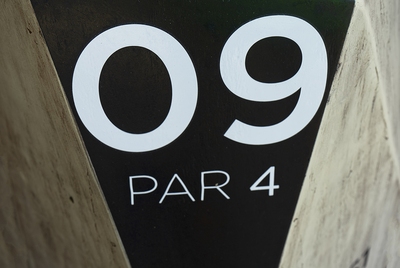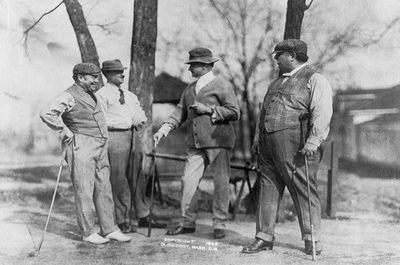In our broader article focusing on golfing terms such as birdie, eagle and indeed par, we explain how golf, like many sports, can sometimes seem to have a vocabulary all of its own. That feature looks more briefly at a number of the many golfing terms you might see should you be betting on golf, playing it, or watching it on the television. Here, however, we will look in more detail at par, a concept which is central to the way golf is played and scored and crucial if you want to understand the sport and how to bet on it.
What Is A Par?
 In golf, the word par is used in a few closely related but slightly different ways. In general terms, par is how many shots in which a good player (i.e. a scratch golfer with a handicap of zero) should expect to complete a given hole. So a hole may be described as a par four, and this means that players will be attempting to take no more than four shots to get from tee to cup. Should they manage to complete the hole in four shots they have scored a par or can be said to have “parred the hole”.
In golf, the word par is used in a few closely related but slightly different ways. In general terms, par is how many shots in which a good player (i.e. a scratch golfer with a handicap of zero) should expect to complete a given hole. So a hole may be described as a par four, and this means that players will be attempting to take no more than four shots to get from tee to cup. Should they manage to complete the hole in four shots they have scored a par or can be said to have “parred the hole”.
If they take just three shots on a par four hole, this is called a birdie and thus they are now described as being “one under par”. Alternatively, should they make five, they would move from level par to one over par. All standard courses are made up of a small number of par three holes, a majority of par fours and a small number of par fives.
The most common structure sees a course have two par threes, two par fives and five par fours on the outward nine holes and the same on the back nine. This is not set in stone however but the majority of courses are structured this way. The number of each of these types of hole can be altered slightly but it is almost unheard of for a top-level course to have fewer than two par fives and two par threes.
You will never see a par two on a course, for reasons that we will explain shortly, whilst holes with a par above five do not feature on any of the major pro tours and are more of a novelty. In theory, clubs could create a hole with any par they wanted but anything above a par five is extremely rare. That said, the longest hole in the UK is thought to be a par six on Westray, one of the Orkney Islands. What’s more, the longest hole in the world is said to stretch to almost 1,100 yards and is a par seven.
Par For The Course
 The phrase “par for the course” has come into the wider lexicon and means that something is about what you expected. It sometimes has a slightly pejorative tilt, for example, one might say “Dave has eaten all the cheese”, to which someone else might say “Well, that’s par for the course”. In golf though, it illustrates how par can be both hole- and course-specific.
The phrase “par for the course” has come into the wider lexicon and means that something is about what you expected. It sometimes has a slightly pejorative tilt, for example, one might say “Dave has eaten all the cheese”, to which someone else might say “Well, that’s par for the course”. In golf though, it illustrates how par can be both hole- and course-specific.
Just as each hole on a course has an allotted par, so too does the course itself. The literal par for the course is simply the cumulative total par for each of the 18 holes. The standard structure that we mentioned above creates a course with a par of 72 and the majority of courses worldwide are par 72.
However, as we said, that structure is not fixed and a small number of top-level golf courses have a par that is 71 or 70, with an even smaller number being par 73. However, if we assume a course has a par of 72, then a player who completes their round in 66 is said to have been “six under par” for the round, or just “six under”, or possibly “minus six” (or -6). If they have a much poorer day and shoot 74 they are “two over”, whilst a 72 would see them stay at level or even par.
How Is Par Set?

Each club sets the par for itself, assigning each hole a par score and thus creating an overall par for the course. There are no hard and fast rules, but par is essentially based on how many shots it is expected it will take a player to reach the green, with a further two shots allowed for putting once the ball is on the putting surface. Given there is always allowance for two putts, par three is the lowest you will see.
As a result of improved technology and sports science, players today hit the ball much further than they did just 20 years ago. The players of 20 years ago, of course, achieved greater distances than their predecessors and so distances used to help judge what par a hole should be. These have changed somewhat over the years. The current USGA guidance for the distance of a hole and its par (for men) states the following:
- Par 3s are up to 260 yards
- Par 4s are between 240 and 490 yards
- Par 5s are between 450 and 710 yards
- Pars 6s are 670 yards and over
You will note that there is some overlap with regards to the distances and this is because the length of a hole is not the only factor. The general difficulty must also be assessed, whilst hills and the prevailing wind can also be considered. Clearly, a 250-yard hole up a steep hill is likely to be a par four, whilst a 260-yard hole down that same slope may well be a par three.
Last of all it should be noted that the distance guidelines above “assume an altitude less than 2,000 feet/610 metres above sea level.” This is because the thinner air at altitude means the ball travels further.
Where Does The Word Par Come From In Golf?
 Before we look at where the word par comes from, let us furnish you with a more interesting fact: a bogey used to be a par! Few people, even real golf fans, are aware of this fact and the word par only really came to be used widely as it is now in the 20th century. For much of golf’s long history before that, it is unclear what terminology was used. But during the late 1800s and into the early 1900s the word bogey was used to denote a “perfect” score.
Before we look at where the word par comes from, let us furnish you with a more interesting fact: a bogey used to be a par! Few people, even real golf fans, are aware of this fact and the word par only really came to be used widely as it is now in the 20th century. For much of golf’s long history before that, it is unclear what terminology was used. But during the late 1800s and into the early 1900s the word bogey was used to denote a “perfect” score.
According to the governing body of golf in America, the USGA a song called “The Bogey Man” (also sometimes known as “The Colonel Bogey March”) was popular in the British Isles at this time. The eponymous Bogey Man “was an elusive figure who hid in the shadows” and the song contained the lyric, “I’m the Bogey Man, catch me if you can.”
Somehow, the search for the Bogey Man became synonymous with the equally difficult and frustrating golfing search for the perfect score. As such, according to the USGA, “the term ‘bogey score’ referred to the ideal score a good player could be expected to make on a hole under perfect conditions”. Somehow, however, over the next 20 years or so, par came to replace bogey, with a bogey shifting to its current meaning of one over, or worse than, par.
The root of the word par is far more prosaic and simply comes from the Latin word which means equal. In the late 16th century it expanded and changed slightly to mean equal in value or standing and then slowly but surely the word found its way into the game of golf.
